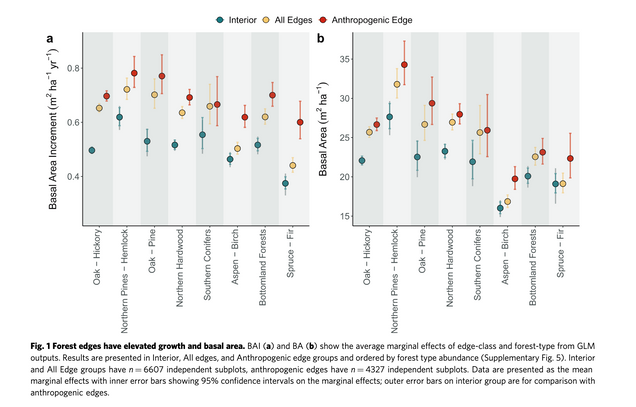Maybe It’s Time to Start Saving Urban Forests
When we think of saving forests we think of big expanses of trees in rural areas, but recent studies have shown that maybe we should start thinking about saving the trees in cities.
Lucy Hutyra, CISE faculty affiliate and CAS Earth and Environment Professor, studies the effects of urbanization and land-use change on ecosystems, but primarily from a carbon dioxide standpoint. Her recent research found that trees around the edges of urban forests grow faster and soil gives off less carbon dioxide. This could have positive implications for dealing with climate change. Her findings were published in the Nature Journal.
Hutyra and her team looked at forest fragmentation in 20 states and compared the forest structure adjacent to anthropogenic land uses. They looked at the basal area (BA) and basal area increment (BAI) of several different species of trees, which is the total cross-sectional area of all stems of a tree at around four feet tall (BA) and the increase in cross-sectional area (BAI).
The data gathered from the Department of Agriculture national Forest Inventory and Analysis dataset, as well as data they measured in the field, shows that no matter the tree species, the BA and BAI increased for forest edges, which grew faster than forest interiors. In particular, anthropogenic forest edges grew the fastest. Tree growth is correlated with an intake of carbon dioxide, which is overall beneficial for the environment.

These findings contrast with previous studies based on tropical forests, which show the opposite effects and lower carbon storage. In the Amazon rainforest, fragmentation caused trees to die and it slowed down their growth rate.
Potential differences in tropical climates could be the additional heat stress and vulnerability to forest fires. Hutyra speculates that forest edges in temperate climates grow faster because have adequate nutrients, and water, but are exposed to additional light.
Trees in the city tend to stand alone which means they have more space for themselves and aren’t competing for sunlight. Cities also have higher ambient carbon dioxide because of the local combustion of fossil fuels. Further, there’s also more water from leaking infrastructure, runoff, and people’s sprinkler systems.
The experiments used a statistical matching approach, meaning forest edges were paired with a forest interior that had similar conditions like temperature, light, amount of nitrogen coming from the sky, and other environmental variables. This created a pseudo experiment that allowed different forests across the US to be compared.
In a separate study, Hutyra and her team looked at the soil at the edges and found that it gave off less carbon dioxide in urban areas. The soil near urban areas was 2.5 degrees warmer compared to the soil in the interior of forests, which could imply that the heat suppressed the biological metabolic activity, releasing less carbon dioxide.
“It’s actually kind of a double effect of taking up more carbon dioxide in trees and releasing less through decomposition processes in the soil. This means efforts to do things like plant a million trees to try to mitigate urban heat island effect might have other valuable impacts on the urban landscape.”

Hutyra said if conditions continue to warm, temperate climates might become more like tropical climates, changing the ways forest edges act and increasing the effects of climate change.
“About a quarter of the carbon dioxide that we’re releasing in the air through the combustion of fossil fuels doesn’t stay in the air. The forests of the world take it up which means that currently, we aren’t feeling the full brunt effect of fossil fuel combustion activities. The forests are doing this massive service for the planet. The question is will that continue?” Hutyra said.
Policy implications for dealing with climate change revolve around the configuration of trees and where to plant them. Depending on if more edges are created, or large pieces of forests are conserved, the outcomes will differ.
“Some species need the habitat of a forest in a rural area which is a great reason to conserve large forests,” Hutyra said. “But a lot of the conservation decisions are made about carbon. This is pointing to a value in conserving smaller pieces of forests that we really hadn’t been accounting for.”